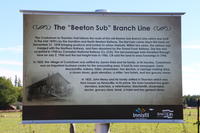Historic Plaques
Pages
-

-
The "Beeton Sub" Branch Line - Cookstown
-
Historic plaque located off Highway 89 (Queen Street) at the entrance to the Cookstown to Thornton trail in Cookstown. It features a photo of the Cookstown train station, as well as the logos for the Town of Innisifl and the County of Simcoe. The sign reads: "The Cookstown to Thornton Trail follow the route of the old Beeton Sub Branch Line which was built in the mid 1870's by the Hamilton and North Western Railway. The first train came down this track on December 31, 1878 bringing produce and lumber to urban markets. Within two years, the railway was merged with the Northern Railway, and then absorbed by the Grand Trunk Railway. The line was acquired in 1920 by Canadian National Railway Co. (CN). The last passenger train travelled through here on July 2, 1960 and the last freight train in 1986. CN sold the land to area Townships in 1996. In 1825, the village of Cookstown was settled by James Kidd and his family. In its heyday, Cookstown was an important business centre for the surrounding area. It has its own newspaper, bank, blacksmiths, bakery, tailor, shoemaker, two doctors, a carriage making shop, a dozen stores, grain elevators, a miller, two hotels, and two grocery stores. In 1833, John Henry and his family settled in Thornton which was then known as Henryville. In its prime, the town boasted two grain elevators, butchers, a veterinarian, blacksmith, shoemaker, doctor, grocery stores, bank, a hotel and two general stores."
-

-
The "Beeton Sub" Branch Line - Thornton
-
Historic plaque located at the entrance to the Cookstown to Thornton trail on the 5th Sideroad. It features a photo of the Cookstown train station, as well as the logos for the Town of Innisifl and the County of Simcoe. The sign reads: "The Cookstown to Thornton Trail follow the route of the old Beeton Sub Branch Line which was built in the mid 1870's by the Hamilton and North Western Railway. The first train came down this track on December 31, 1878 bringing produce and lumber to urban markets. Within two years, the railway was merged with the Northern Railway, and then absorbed by the Grand Trunk Railway. The line was acquired in 1920 by Canadian National Railway Co. (CN). The last passenger train travelled through here on July 2, 1960 and the last freight train in 1986. CN sold the land to area Townships in 1996. In 1825, the village of Cookstown was settled by James Kidd and his family. In its heyday, Cookstown was an important business centre for the surrounding area. It has its own newspaper, bank, blacksmiths, bakery, tailor, shoemaker, two doctors, a carriage making shop, a dozen stores, grain elevators, a miller, two hotels, and two grocery stores. In 1833, John Henry and his family settled in Thornton which was then known as Henryville. In its prime, the town boasted two grain elevators, butchers, a veterinarian, blacksmith, shoemaker, doctor, grocery stores, bank, a hotel and two general stores."
-

-
Tyrone
-
Historic plaque located at the intersection of Yonge Street and the 5th Line, north of Churchill. The sign features a photo of the the Tyrone schoolhouse (S.S. #7) in the bottom left corner, as well as the logo for the Town of Innisfil in the bottom right corner. The text reads: "The hamlet of Tyrone was an Irish settlement, separating itself from the Scottish settlement at Churchill. The first log school, built in 1856, was replaced by a frame structure that burned in 1938. The present brick building was erected as a result, and can still be seen near here on the west side of Yonge Street. At one time there were two gas stations and a few houses here. The "Tyrone Tavern" operated by Irwin Moore, stood at the south-east corner from 1852 to 1862. Later, George Hart, living in the cobblestone house at the north-west corner, operated a Texaco gas station and garage from another cobblestone building right at the corner."
-

-
Veterans Memorial Park
-
Historic plaque located near the cenotaph off of Church Street in the community of Cookstown. It bears the logos of the Town of Innisfil as well as the County of Simcoe. The sign reads: "During the First World War, sixty-five men from the village of Cookstown and vicinity enlisted to serve King and Country overseas in the Canadian Expeditionary Forces. As a tribute to the sacrifice and bravery of these men, a committee of local residents was formed in 1917 with the task of creating a dignified and lasting memorial to those who served and to those who paid the ultimate sacrifice. The idea of a Memorial Park was born. In the Park's initial phase, to honor each man who enlisted, residents planted sixty-five Maple trees on land donated by the Cookstown Agricultural Society. Most of these trees still stand proudly at this site. The cenotaph located at this Park was designed and constructed by Alfred Davis of Lefroy. It was officially dedicated by the community in August 1935."
Pages
